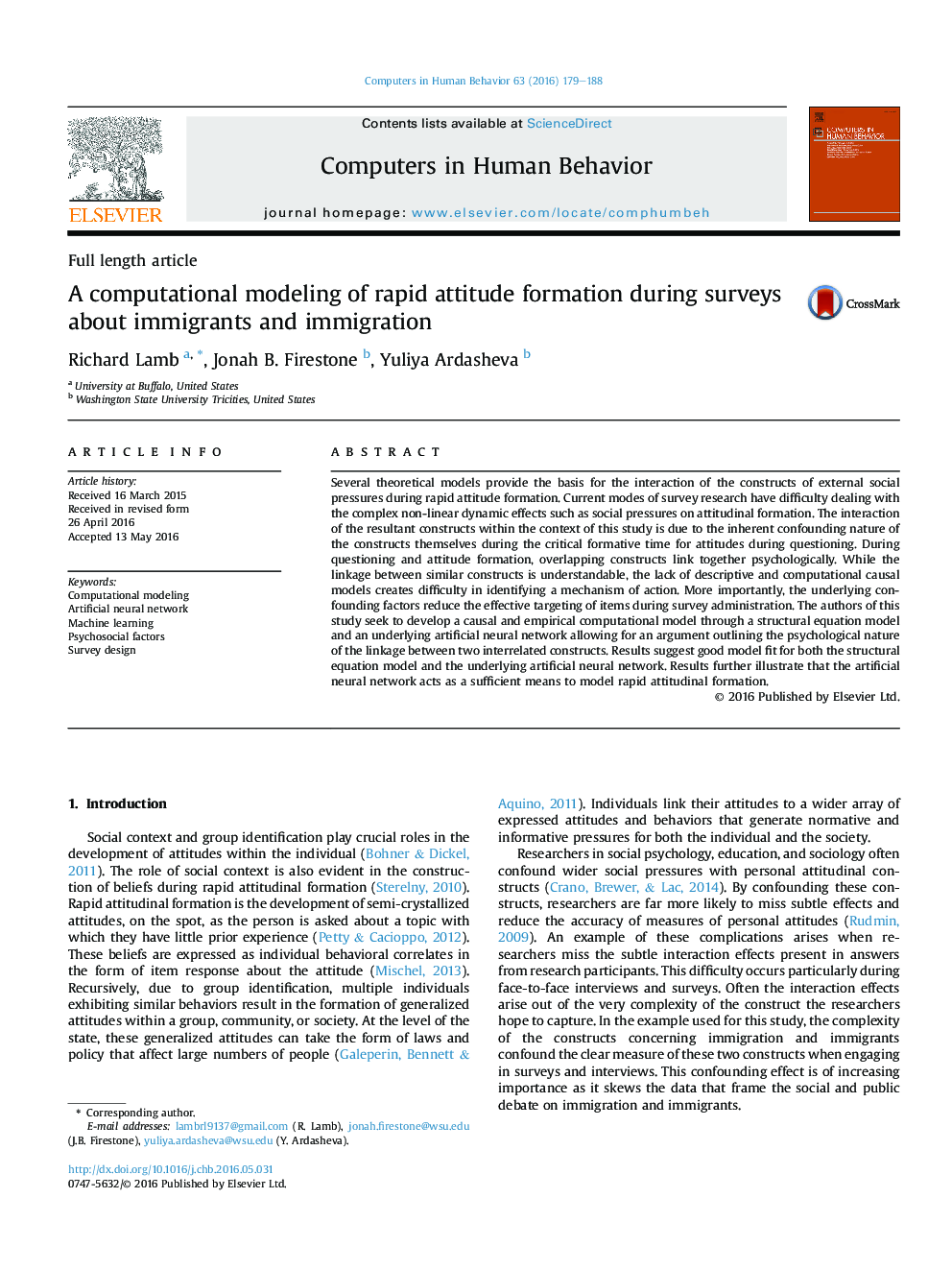| کد مقاله | کد نشریه | سال انتشار | مقاله انگلیسی | نسخه تمام متن |
|---|---|---|---|---|
| 6836582 | 618425 | 2016 | 10 صفحه PDF | دانلود رایگان |
عنوان انگلیسی مقاله ISI
A computational modeling of rapid attitude formation during surveys about immigrants and immigration
ترجمه فارسی عنوان
مدلسازی محاسباتی از شکل گیری نگرش سریع در طی بررسی های مهاجران و مهاجرت
دانلود مقاله + سفارش ترجمه
دانلود مقاله ISI انگلیسی
رایگان برای ایرانیان
کلمات کلیدی
مدل سازی محاسباتی، شبکه های عصبی مصنوعی، فراگیری ماشین، عوامل روانشناختی، طراحی نظرسنجی
ترجمه چکیده
چندین مدل نظری مبنایی برای تعامل سازه های فشارهای اجتماعی خارجی در طول تشکیل نگرش سریع فراهم می کند. روش های کنونی بررسی تحقیقات در مقابله با اثرات پیچیده غیر خطی پویا مانند فشارهای اجتماعی بر شکل گیری نگرش مشکل است. تعامل ساختارهای نتیجه در بستر این مطالعه به علت ماهیت متداول ذاتی سازنده خود در طول زمان شکل گیری انتقادی برای نگرش ها در طول سوال است. در طول پرسش و شکل گیری نگرش، ساختارهای همپوشانی روان شناختی پیوند دارند. در حالی که ارتباط بین سازه های مشابه قابل فهم است، فقدان مدل های علمی توصیفی و محاسباتی، ایجاد مشکل در شناسایی مکانیسم عمل را ایجاد می کند. مهمتر از همه، عوامل مواجههی پایه، اهداف موثر اقلام را در حین نظارت بر مدیریت کاهش می دهند. نویسندگان این مطالعه به دنبال ایجاد یک مدل محاسباتی علی و تجربی از طریق یک مدل معادلات ساختاری و یک زیر ساخت شبکه عصبی مصنوعی است که اجازه می دهد تا استدلالی را ارائه نماییم که ماهیت روانشناختی ارتباط بین دو ساختار درونی دارد. نتایج نشان می دهد که مدل مناسب برای هر دو مدل معادلات ساختاری و شبکه زیرین شبکه عصبی مصنوعی مناسب است. نتایج بیشتر نشان می دهد که شبکه عصبی مصنوعی به عنوان ابزار کافی برای مدل سازی شکل گیری نگرش سریع عمل می کند.
موضوعات مرتبط
مهندسی و علوم پایه
مهندسی کامپیوتر
نرم افزارهای علوم کامپیوتر
چکیده انگلیسی
Several theoretical models provide the basis for the interaction of the constructs of external social pressures during rapid attitude formation. Current modes of survey research have difficulty dealing with the complex non-linear dynamic effects such as social pressures on attitudinal formation. The interaction of the resultant constructs within the context of this study is due to the inherent confounding nature of the constructs themselves during the critical formative time for attitudes during questioning. During questioning and attitude formation, overlapping constructs link together psychologically. While the linkage between similar constructs is understandable, the lack of descriptive and computational causal models creates difficulty in identifying a mechanism of action. More importantly, the underlying confounding factors reduce the effective targeting of items during survey administration. The authors of this study seek to develop a causal and empirical computational model through a structural equation model and an underlying artificial neural network allowing for an argument outlining the psychological nature of the linkage between two interrelated constructs. Results suggest good model fit for both the structural equation model and the underlying artificial neural network. Results further illustrate that the artificial neural network acts as a sufficient means to model rapid attitudinal formation.
ناشر
Database: Elsevier - ScienceDirect (ساینس دایرکت)
Journal: Computers in Human Behavior - Volume 63, October 2016, Pages 179-188
Journal: Computers in Human Behavior - Volume 63, October 2016, Pages 179-188
نویسندگان
Richard Lamb, Jonah B. Firestone, Yuliya Ardasheva,
